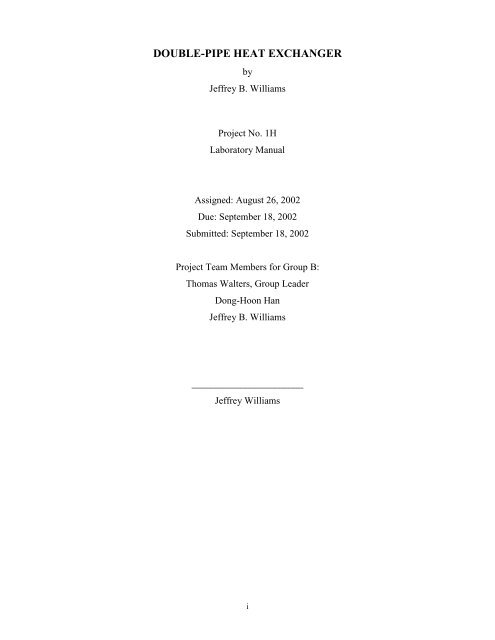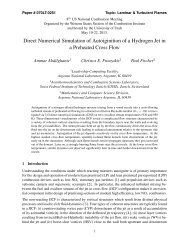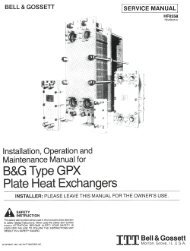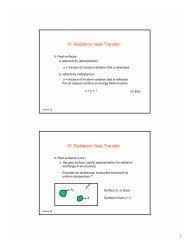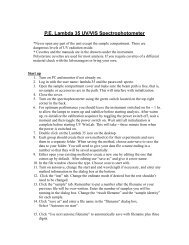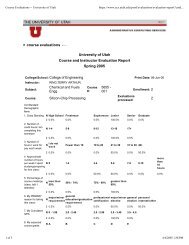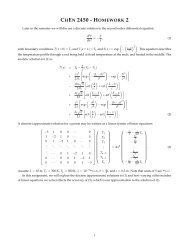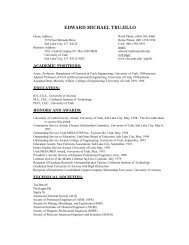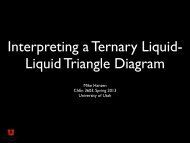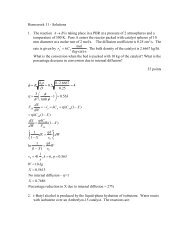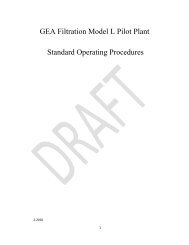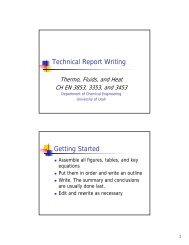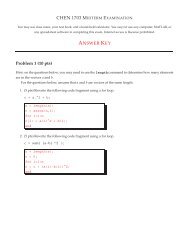DOUBLE-PIPE HEAT EXCHANGER
DOUBLE-PIPE HEAT EXCHANGER
DOUBLE-PIPE HEAT EXCHANGER
You also want an ePaper? Increase the reach of your titles
YUMPU automatically turns print PDFs into web optimized ePapers that Google loves.
<strong>DOUBLE</strong>-<strong>PIPE</strong> <strong>HEAT</strong> <strong>EXCHANGER</strong><br />
by<br />
Jeffrey B. Williams<br />
Project No. 1H<br />
Laboratory Manual<br />
Assigned: August 26, 2002<br />
Due: September 18, 2002<br />
Submitted: September 18, 2002<br />
Project Team Members for Group B:<br />
Thomas Walters, Group Leader<br />
Dong-Hoon Han<br />
Jeffrey B. Williams<br />
_______________________<br />
Jeffrey Williams<br />
i
TABLE OF CONTENTS<br />
SUMMARY<br />
iv<br />
I. INTRODUCTION 1<br />
II. THEORY 3<br />
III. EQUPMENT SPECIFICATIONS 6<br />
IV. SYSTEM OVERVIEW 11<br />
V. PROCEDURE 13<br />
A. OPTO-22 13<br />
B. USING DATA IN EXCEL 15<br />
C. SYSTEM STARTUP 17<br />
D. TURNING ON THE STEAM 17<br />
E. CALIBRATION OF THE FLOW METERS 18<br />
F. MAKING MEASUREMENTS 18<br />
G. SAFETY 19<br />
TABLE OF NOMENCLATURE 21<br />
REFERENCES 23<br />
ii
LIST OF FIGURES<br />
No. Title Page<br />
1. Pump 6<br />
2. Gate Valve 7<br />
3. Disk Globe Valve 7<br />
4. Ball Valve 8<br />
5. Control Valve 8<br />
6. Flow Meter 9<br />
7. Process Flow Diagram of Double-Pipe Heat Exchanger 11<br />
8. Photo of Double-Pipe Heat Exchanger 12<br />
9. Loading the Heat Exchanger Software 13<br />
10. Selecting the Double-Pipe Heat Exchanger 13<br />
11. Opto-22 Interface 14<br />
12. Opening the Double-Pipe Data 15<br />
13. Text Wizard Step One 15<br />
14. Text Wizard Step Two 16<br />
15. Text Wizard Step Three 16<br />
16. Pump Power Switch 19<br />
iii
SUMMARY<br />
Double-Pipe Heat Exchanger, Project No. 1H<br />
Group B<br />
Jeffrey B. Williams (report author), Thomas Walters, Dong-Hoon Han<br />
Report Date: September 18, 2002<br />
A Procedures Manual was created for the double-pipe heat exchanger. The theories of transient<br />
heat transfer in double-pipe heat exchangers were explained and followed by literature correlations.<br />
All of the instrument specifications were defined. A procedure for use of the equipment and the<br />
software was outlined. Safety and other concerns during operation were discussed. This manual will<br />
serve to direct anyone in how to start up and run the double-pipe heat exchanger.<br />
It is recommended that this Procedures Manual be filed with Robert Cox in MEB 3520. It is<br />
recommended that students be given access to the following manual, to aid them in their understanding<br />
of the use of the equipment. It is also recommended that students begin with a calibration of the flow<br />
meters and possibly the thermocouples before beginning use of the equipment. All calibration data,<br />
where possible, should be coordinated with the computer-generated data.<br />
iv
I. INTRODUCTION<br />
Temperature can be defined as the amount of energy that a substance has. Heat<br />
exchangers are used to transfer that energy from one substance to another. In process units it is<br />
necessary to control the temperature of incoming and outgoing streams. These streams can<br />
either be gases or liquids. Heat exchangers raise or lower the temperature of these streams by<br />
transferring heat to or from the stream.<br />
Heat exchangers are a device that exchange the heat between two fluids of different<br />
temperatures that are separated by a solid wall. The temperature gradient, or the differences in<br />
temperature facilitate this transfer of heat. Transfer of heat happens by three principle means:<br />
radiation, conduction and convection. In the use of heat exchangers radiation does take place.<br />
However, in comparison to conduction and convection, radiation does not play a major role.<br />
Conduction occurs as the heat from the higher temperature fluid passes through the solid wall.<br />
To maximize the heat transfer, the wall should be thin and made of a very conductive material.<br />
The biggest contribution to heat transfer in a heat exchanger is made through convection.<br />
In a heat exchanger forced convection allows for the transfer of heat of one moving<br />
stream to another moving stream. With convection as heat is transferred through the pipe wall it<br />
is mixed into the stream and the flow of the stream removes the transferred heat. This maintains<br />
a temperature gradient between the two fluids.<br />
The double-pipe heat exchanger is one of the simplest types of heat exchangers. It is<br />
called a double-pipe exchanger because one fluid flows inside a pipe and the other fluid flows<br />
between that pipe and another pipe that surrounds the first. This is a concentric tube construction.<br />
Flow in a double-pipe heat exchanger can be co-current or counter-current. There are two flow<br />
configurations: co-current is when the flow of the two streams is in the same direction, counter<br />
current is when the flow of the streams is in opposite directions.<br />
As conditions in the pipes change: inlet temperatures, flow rates, fluid properties, fluid<br />
composition, etc., the amount of heat transferred also changes. This transient behavior leads to<br />
1
change in process temperatures, which will lead to a point where the temperature distribution<br />
becomes steady. When heat is beginning to be transferred, this changes the temperature of the<br />
fluids. Until these temperatures reach a steady state their behavior is dependent on time.<br />
In this double-pipe heat exchanger a hot process fluid flowing through the inner pipe<br />
transfers its heat to cooling water flowing in the outer pipe. The system is in steady state until<br />
conditions change, such as flow rate or inlet temperature. These changes in conditions cause the<br />
temperature distribution to change with time until a new steady state is reached. The new steady<br />
state will be observed once the inlet and outlet temperatures for the process and coolant fluid<br />
become stable. In reality, the temperatures will never be completely stable, but with large<br />
enough changes in inlet temperatures or flow rates a relative steady state can be experimentally<br />
observed.<br />
2
II. THEORY<br />
The theory behind the operation of a double-pipe heat exchanger is covered in Incropera<br />
and Dewitt (1996). Also in this same textbook is the derivation of how transient behavior is<br />
treated with respect to heat transfer.<br />
As with any process the analysis of a heat exchanger begins with an energy and material<br />
balance. Before doing a complete energy balance a few assumptions can be made. The first<br />
assumption is that the energy lost to the surroundings from the cooling water or from the U-<br />
bends in the inner pipe to the surroundings is negligible. We also assume negligible potential or<br />
kinetic energy changes and constant physical properties such as specific heats and density.<br />
These assumptions also simplify the basic heat-exchanger equations.<br />
The determination of the overall heat-transfer coefficient is necessary in order to<br />
determine the heat transferred from the inner pipe to the outer pipe. This coefficient takes into<br />
account all of the conductive and convective resistances (k and h, respectively) between fluids<br />
separated by the inner pipe, and also takes into account thermal resistances caused by fouling<br />
(rust, scaling, i.e.) on both sides of the inner pipe. For a double-pipe heat exchanger the overall<br />
heat transfer coefficient, U, can be expressed as<br />
1 1 R<br />
fo 1 ⎛ d<br />
i,<br />
= + + ln<br />
U A Ao<br />
ho<br />
Ao<br />
2 k l<br />
⎜<br />
• • • π • ⎝ di,<br />
o<br />
i<br />
⎞ R<br />
fi<br />
⎟ +<br />
⎠ Ai<br />
1<br />
+ .<br />
hi<br />
• Ai<br />
( 1)<br />
In a heat exchanger the log-mean temperature difference is the appropriate average<br />
temperature difference to use in heat transfer calculations. The equation for the log-mean<br />
temperature difference is<br />
∆T<br />
LM<br />
=<br />
( T − T ) − ( T − T )<br />
i,<br />
o<br />
o,<br />
i<br />
⎛ Ti<br />
ln⎜<br />
⎝ Ti<br />
, o<br />
, i<br />
− T<br />
i,<br />
i<br />
− T<br />
o,<br />
i<br />
o,<br />
o<br />
⎞<br />
⎟<br />
⎠<br />
o,<br />
o<br />
.<br />
( 2)<br />
3
Fluid properties such as density, viscosity and heat capacity are evaluated at the average<br />
temperatures. The average is found by using the inlet and outlet values<br />
T i,<br />
a<br />
T o,<br />
a<br />
=<br />
=<br />
T + T<br />
i, o i,<br />
i<br />
2<br />
T + T<br />
o, o o,<br />
i<br />
2<br />
. (3)<br />
. (4)<br />
Thermal conductivity, k, can be evaluated at the average of the average temperatures. In a<br />
double-pipe heat exchanger the inner pipe is made of a conductive metal and is thin.<br />
The problem can be further simplified if the equipment is assumed to be clean, which<br />
means that no scaling exists. This is a poor simplification with the double-pipe heat exchanger<br />
in the laboratory, because it is many years old. The fouling factors R fo and R fi can be looked up<br />
from various sources, including Standards of the Tubular Exchange Manufacturers Association,<br />
or lumped together and determined experimentally.<br />
The only part of the overall heat-transfer coefficient that needs to be determined is the<br />
convective heat-transfer coefficients. Correlations are used to relate the Reynolds number to the<br />
heat-transfer coefficient. The Reynolds number is a dimensionless ratio of the inertial and<br />
viscous forces in flow.<br />
d<br />
m<br />
i,<br />
i i<br />
Re<br />
i<br />
= . (5)<br />
µ<br />
iai<br />
In the inner pipe if the Reynolds is less than 2000 this is considered to be laminar flow and the<br />
Nusselt number is equal to 4.36. If the Reynolds number is greater than 10,000, the Nusselt<br />
number is given by<br />
for turbulent,<br />
fully developed<br />
flow where<br />
Nu<br />
i<br />
= 0.023Re<br />
4 5<br />
i<br />
Pr<br />
n<br />
i<br />
⎛ l ⎞<br />
Rei<br />
≥ 10,000, ⎜ ⎟<br />
10, 0.6 Pri<br />
160,<br />
d<br />
≥ ≤ ≤<br />
⎝ i,<br />
i ⎠<br />
n = 0.4 for T > T or n = 0.3 for T > T .<br />
s<br />
m<br />
m<br />
s<br />
( 6)<br />
Cp<br />
iµ<br />
i<br />
Pri<br />
= .<br />
k<br />
i<br />
( 7)<br />
4
This gives a Nusselt number that can then be use to find h i<br />
Nu =<br />
i<br />
h d<br />
i<br />
k<br />
i,<br />
i<br />
i<br />
.<br />
( 8)<br />
The convective heat transfer coefficient in the annulus is more difficult to determine.<br />
The hydraulic diameter is used to find the Reynolds number. The hydraulic diameter is defined<br />
as the cross-sectional area perpendicular to flow divided by the wetted perimeter. With the<br />
Reynolds number calculated the same correlations apply and with these h o can be determined.<br />
Once all the separate heat-transfer coefficients are calculated an overall heat transfer<br />
coefficient is calculated. Now everything that was necessary for an energy balance is available.<br />
With the previous assumptions made earlier the dynamic equations would be<br />
dTi,<br />
a<br />
mi<br />
• Cpi<br />
• = qi<br />
• ρi<br />
• Cp<br />
dt<br />
dT 0, a<br />
mo<br />
• Cpo<br />
• = qo<br />
• ρ<br />
o<br />
• Cp<br />
dt<br />
−<br />
i<br />
( Ti,<br />
i<br />
Ti,<br />
o<br />
−<br />
o<br />
( To,<br />
i<br />
To,<br />
o<br />
) −U<br />
• A • ∆T<br />
LM<br />
) + U • A • ∆T<br />
.<br />
LM<br />
.<br />
( 9)<br />
( 10)<br />
With the transient data taken experimentally an overall heat-transfer coefficient can be<br />
determined at each time step. This can be solved numerically.<br />
5
III. EQUIPMENT SPECIFICATIONS<br />
The following is a list of all pieces of equipment and their specifications for the double-pipe heat<br />
exchanger.<br />
1) Pump<br />
Manufactured by: Dayton Electric Manufacturing<br />
Model: Teel Industrial Series (see Figure 1)<br />
Horsepower 2<br />
RPM: 3485<br />
Efficiency 80<br />
Incoming pipe diameter: 2 in, Schedule 40 stainless steel<br />
Outlet pipe diameter: 1 1/2 in, Schedule 40 stainless steel<br />
Figure 1 – This Pump is used to pump the fluid from the<br />
tank to double-pipe exchanger.<br />
2) Double-Pipe Heat Exchanger<br />
Material:<br />
Schedule 40 stainless steel<br />
Length:<br />
14 ft<br />
Inside Pipe Diameter: 1 1/4 in<br />
Outside Pipe Diameter: 2 in<br />
Steam Pass 1<br />
Cooling Water Pass 4<br />
6
3) Valves<br />
• Gate Valves<br />
Manufactured by: Stockham<br />
Location: Steam Valves (see Figure 2)<br />
Figure 2 – This valve allows steam to enter the steam pipe<br />
in the annulus of the double-pipe heat exchanger.<br />
• Disk Globe Valve<br />
Manufactured by: Nibco<br />
Location: Cold Water Valves (see Figure 3)<br />
Figure 3 – When this valve is open the cold water can<br />
enter the double-pipe heat exchanger.<br />
• Ball Valves<br />
Manufactured by:<br />
Watts Regulator or Apollo<br />
7
Location:<br />
Process Valves, Tank Valve, Drain Valve<br />
(see Figure 4)<br />
Figure 4 – When the valve (Apollo) on the left is open it allows the<br />
cooling water to travel to the drain. When the valve (Watts Regulator)<br />
on the right is open, the process fluid can travel to the drain.<br />
• Computer Controlled Valves<br />
Manufactured by: Scott Johnson<br />
Model: Valtek (see Figure 5)<br />
Operating Temperature: 0 to 55°C<br />
Maximum Air Pressure: 30 psig<br />
Figure 5- Control valve used to control amount<br />
of coolant flow to the heat exchanger.<br />
8
4) Flow meters<br />
Manufactured by: Brooks Instruments<br />
Model: MT 3810 (see figure 6)<br />
Accuracy:<br />
±5% full scale from 100% to 10% of scale<br />
reading<br />
Repeatability:<br />
0.25% full scale<br />
Operating Temperature: -39 to 215°C<br />
Flow Range:<br />
4.1 to 41.6 gpm for inner-pipe flow meter<br />
2.6 to 26.4 gpm for outer-pipe flow meter<br />
5) Thermocouples<br />
Figure 6 – Meter measures the flow of process<br />
fluid coming from the pump.<br />
Manufactured by:<br />
Model:<br />
Sheath Material:<br />
Sheath Length:<br />
Omega<br />
Type T<br />
304 Stainless Steel<br />
12 in<br />
Temperature Range: -60 to 100°C<br />
Accuracy:<br />
1.0°C or 0.75% above 0°C (whichever is<br />
greater)<br />
1.0°C or 1.5% below 0°C (whichever is<br />
greater)<br />
9
6) Low Pressure Steam<br />
Pressure:<br />
27 psia<br />
Temperature: 118°C<br />
7) Computer<br />
Manufactured by:<br />
Operating System:<br />
Software:<br />
Dell Systems<br />
Windows NT<br />
Opto-22 electronics and computer based<br />
software, Version R3.16. Copyright 1996-<br />
2000 Opto-22.<br />
10
IV. SYSTEM OVERVIEW<br />
The double-pipe heat exchanger used in experimentation is located in MEB 3520.<br />
Figure 7 describes the setup of double-pipe heat exchanger. Fluid from the tank is first heated in<br />
the by steam that is condensing in the annulus and is then cooled by the four cooling-water<br />
passes. In all instances low-pressure steam is used to heat the fluid and water is used to cool the<br />
fluid. Once cooled the fluid is then returned to the tank.<br />
There are six thermocouples that record temperature at six different points that can be<br />
seen in the following figure. The first records the temperature of the inlet process fluid, the<br />
second records the process fluid temperature after heating with steam, the third records the<br />
temperature after cooling with the water, the fourth records the cooling-water temperature at the<br />
inlet, the fifth records at the outlet and the sixth records the steam temperature at the inlet.<br />
There is a control valve that controls the steam inlet, the process fluid inlet and the cooling-water<br />
outlet. There are manual valves that also need to be opened before the process could begin, even<br />
if the control valves were open to 100%. Once the proper valves are opened the pump can be<br />
manually activated.<br />
Figure 7- Process flow diagram for the double-pipe heat exchanger<br />
11
Figure 8 is a full overview of the double-pipe heat exchanger taken from the south side.<br />
The disk included with this manual includes this picture, as well as other pictures.<br />
Figure 8- Picture of the double-pipe heat exchanger from the southwest corner<br />
12
V. PROCEDURE<br />
A. OPTO-22 Software<br />
The valves on the double-pipe heat exchanger are electronically controlled, and the data from<br />
the thermocouples and the flow meters are taken via computer. The following steps will<br />
explain how to start the software, and what the various sections of the software mean.<br />
1. Turn on the computer.<br />
2. Click on the icon reading “Shortcut to Heat Exchanger MMI.” This will load<br />
the Opto-22 software.<br />
3. The first screen that appears will look like this:<br />
Figure 9- Loading the heat-exchanger software.<br />
4. Click on the Heat-Exchanger Menu button. At this time, another menu will<br />
come up.<br />
Figure 10- Selecting the double-pipe heat exchanger<br />
5. Select the “Double Pipe”.<br />
6. Figure 11 opens up next. This is the Opto-22 interface screen. All the work<br />
that is done while the heat exchanger is operating will be done here. For both<br />
the cooling and the water (process) flow the manipulated variable (MV) is the<br />
13
percent opening of the respective control valves. 100% means that the valve is<br />
fully opened and 0% means that the valve is completely closed. The valve<br />
setting is changed by opening up the green MV and inputting a value of<br />
0-100.<br />
Figure 11- Opto-22 interface and control screen<br />
7. The lower portion of Figure 11 shows values for the six different<br />
thermocouple readings, for the coolant and process flow meters and also for<br />
the control valves themselves. The colors in these boxes correspond with the<br />
colors of the lines in the graphs. This Opto screen provides numerical values<br />
and plots the numerical values to the graph. A new reading is taken and<br />
recorded at least every 5 seconds. Old data are saved to a file and are<br />
accessible in this screen.<br />
14
B. USING DATA IN EXCEL<br />
1. Open the file in Excel. It is found in the C drive in “double-pipe data”.<br />
Figure 12 – Opening the double-pipe data<br />
2. The data are saved in comma-delimited form. So Excel has to convert this to<br />
rows and columns.<br />
Figure 13 – Text wizard Step one indicates that the data are in delimited form<br />
15
Figure 14 – The data are delimited using commas, this<br />
is apparent from the preview<br />
Figure 15 – The last step in the import wizard is<br />
to specify the data format of the columns and create the spreadsheet<br />
3. Once in Excel the data can then be studied and used in any necessary<br />
calculations. All the data (thermocouple readings, flow measurements and %<br />
control valve opening) given on the Opto-22 interface are recorded in this<br />
style for later use. Data such as this are very useful in the study of transient<br />
behavior.<br />
16
C. SYSTEM STARTUP<br />
Between runs and at startup, the heat exchanger has to be cleaned in order to<br />
remove any rust or scale that has built up in the pipes.<br />
1. Make sure the computer is on, and the Opto-22 software is running on the<br />
double-pipe heat exchanger. Open both the valves to 100%.<br />
2. Open the globe valve to the cold water. Close valve that allows water to the<br />
reach the tank. Allow time for the cooling water to flush the coolant pipe.<br />
3. Close the ball valve to the recycle, the tank and to the drain. Open the ball<br />
valve that allows mixing of cooling water and process fluid. This will allow<br />
the cooling water to run through the inner pipe and clean out any debris or<br />
deposits.<br />
4. Once the tank is about half way full open the tank valve and the drain valve<br />
and allow tank and inner pipe to drain, repeat this same process until the<br />
process fluid looks clean.<br />
5. Once the fluid is clean close the tank valve, close the drain valve and proceed<br />
to fill the tank.<br />
6. When finished, close the valve that allows the cooling water to mix with the<br />
process fluid. This will close the loop to the process. Open the drain valve to<br />
allow cooling water to cycle.<br />
D. TURNING ON THE STEAM<br />
1. Get a ladder, put on thermal resistant gloves and open the steam valve above<br />
the heat exchanger.<br />
2. Open the inlet steam valve to the exchanger.<br />
3. Open the outlet steam (gate) valve.<br />
4. The steam trap will capture the steam and condense it. This will control the<br />
flow of steam to the exchanger. The steam will condense as it transfers it’s<br />
heat to the process fluid. The steam trap will allow only liquid to the steam<br />
drain.<br />
17
E. CALIBRATION OF THE FLOW METERS<br />
Simple calibrations can be made for the flow meters. Calibrated data should be<br />
compared not only with the instrument itself, but when and where possible also<br />
with Opto-22. The thermocouples should not be removed from the heat<br />
exchanger, however the thermocouples still need to be calibrated regularly, if and<br />
when, necessary calibration of the thermocouples should take place<br />
1. Use a bucket or other container that can hold water. The container should<br />
have a volume of at least 3 gallons, but not exceed 5 gallons. Obtain a scale<br />
that can measure mass up to 10 kg. Obtain a stopwatch.<br />
2. Determine what range of flow rates that are necessary to give the required<br />
conditions. At least three separate flow rates should be used.<br />
3. Open or close the control valve to give the needed flow rates.<br />
4. Record the flow rate both on the computer and on the flow meter; these should<br />
be the same.<br />
5. Have one person record time, one person hold the bucket and one person<br />
watch the flow meter to look for variation in the flow.<br />
6. Weigh the empty bucket.<br />
7. Fill the bucket from the tank inlet, record the time it takes to fill the bucket.<br />
8. Record the temperature of the outgoing stream.<br />
9. Weigh the bucket with water. Find the weight of the water.<br />
10. Determine the flow rate using density of the fluid at the recorded temperature<br />
11. Repeat the calibration two to four times.<br />
F. MAKING MEASUREMENTS<br />
Once the flow meters have been calibrated and the system is flushed of any loose<br />
scaling, measurements can be made. Depending on the nature of the experiments<br />
to be performed, whether they be steady- or unsteady-state, the following<br />
procedure might vary. It is recommended however to first open the control valves<br />
to a setting that allows the type of flow that is needed, whether it be laminar or<br />
18
turbulent. Second is to activate the pump to give the needed flow in the process<br />
fluid. Figure 16 shows the pump control on the west wall that needs to be used.<br />
The pump on the operators left is the one that is used for the double-pipe heat<br />
exchanger. Once the pump is activated, wait and see when the system reaches<br />
steady state and then make any necessary changes to the system.<br />
Figure 16 – The pump power switch is the switch on the left.<br />
These power switches are located on the wall behind the heat exchanger.<br />
G. SAFETY<br />
Safety precaution is of utmost importance with any process. At all times operators of<br />
the equipment should wear safety glasses and hardhats, especially when the steam is<br />
turned on, or people are working on ladders (with the steam valves). When opening<br />
or closing the steam valves, always wear heat-resistant gloves. After the steam is<br />
turned on, care must be exercised as the water and pipes will become warm. Avoid<br />
touching the warm metal. Most of the critical areas are insulated; however, there are<br />
several exposed pipes that can become quite warm. The level of water in the tank<br />
should be kept at least one-third full to decrease the amount of splashing, especially<br />
when the water is hot. As water spills may occur, it is also important to have a mop<br />
and bucket on hand whenever the heat exchanger is used. Clean up any spills<br />
immediately to avoid damaging any electronics, especially on the computer<br />
19
controlling the equipment or the pump. It is important to keep the area surrounding<br />
the pump clear. While it is enclosed and mounted, the pump does require ventilation.<br />
Also, never run the pump dry or run it with the process and with the bypass valve<br />
shut. Not only does it wear out the valves and seals, but the pump can also overheat.<br />
20
TABLE OF NOMENCLATURE<br />
Symbols<br />
A =Area for heat transfer, ft 2<br />
A i,i =Surface area of the inside of the inner pipe, ft 2<br />
A i,o =Surface area of the outside of the inner pipe, ft 2<br />
a i =Cross sectional area of inner pipe, ft 2<br />
Cp i =Heat capacity of the fluid in the inner pipe, Btu/lbm . o F<br />
Cp o =Heat capacity of the fluid in the outer pipe, Btu/lbm .o F<br />
D i,,i<br />
d o,,i<br />
d i,,o<br />
d o,,o<br />
h i<br />
h o<br />
k<br />
l<br />
m i<br />
m o<br />
Nu i<br />
Nu i<br />
Pr i<br />
Pr o<br />
Re i<br />
Re o<br />
T i,i<br />
T o,i<br />
T i,o<br />
T o,o<br />
=Inner diameter of inner pipe, ft<br />
=Inner diameter of outer pipe, ft<br />
=Outer diameter of inner pipe, ft<br />
=Outer diameter of Outer pipe, ft<br />
=Convective heat-transfer coefficient of fluid in inner pipe, Btu/hr . ft 2.o F<br />
=Convective heat-transfer coefficient of fluid in outer pipe, Btu/hr . ft 2.o F<br />
=Thermal conductivity of inner pipe material, Btu/hr . ft .o F<br />
=Total pipe length, ft<br />
=Mass of fluid in inner pipe, lbm<br />
=Mass of fluid in outer pipe, lbm<br />
=Nusselt number of fluid in inner pipe<br />
=Nusselt number of fluid in outer pipe<br />
=Prandtl number of fluid in inner pipe<br />
=Prandtl number of fluid in outer pipe<br />
=Reynolds number of fluid in inner pipe<br />
=Reynolds number of fluid in outer pipe<br />
=Inlet temperature of fluid in inner pipe, o F<br />
=Inlet temperature of fluid in outer pipe, o F<br />
=Outlet temperature of fluid in inner pipe, o F<br />
=Outlet temperature of fluid in outer pipe, o F<br />
DT LM =Log-mean temperature difference<br />
T i,a<br />
T o,a<br />
=Average temperature of fluid in inner pipe, o F<br />
=Average temperature of fluid in inner pipe, o F<br />
21
Rf i =Fouling factor inside the inner pipe, Btu/hr . ft 2.o F<br />
Rf o =Fouling factor outside the inner pipe, Btu/hr . ft 2.o F<br />
u i<br />
u o<br />
=Velocity of the fluid in the inner pipe, ft/s<br />
=Velocity of the fluid in the outer pipe, ft/s<br />
q i =Volumetric flow rate of the fluid in the inner pipe, ft 3 /s<br />
q o =Volumetric flow rate of the fluid in the inner pipe, ft 3 /s<br />
Q =Heat transfer rate, Btu/hr<br />
U =Overall heat-transfer coefficient, Btu/hr . ft 2.o F<br />
Greek Symbols<br />
ρ i =Density of the fluid in the inner pipe, lbm/ft 3<br />
ρ o =Density of the fluid in the outer pipe, lbm/ft 3<br />
µ i =Viscosity of the fluid in the inner pipe, lbm/ft . s<br />
µ o =Viscosity of the fluid in the inner pipe, lbm/ft . s<br />
22
REFERENCES<br />
1. deNevers, N., Fluid Mechanics, McGraw Hill, (1991).<br />
2. Emerson Process Management product guide.http://www.emersonprocess.com/ brooks/<br />
products/products3d.html (accessed Sept 2002).<br />
3. Incropera, F.P., D.P. DeWitt, Fundamentals of Heat and Mass Transfer, John Wiley &<br />
Sons, Inc., pp. 460, 582-612. (1996).<br />
4. Redding, Alyssa M., Shell-and-Tube Heat Exchanger, Project 1, Laboratory Manual.<br />
Sept. 21, 2001.<br />
5. Standards of the Tubular Exchange Manufacturers Association, 6 th ed., Tubular<br />
Exchanger Manufacturers Association, New York, 1978.<br />
23


